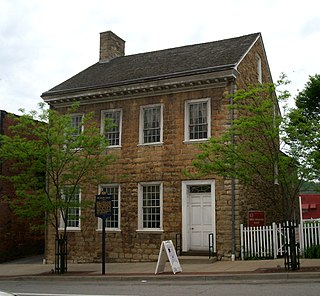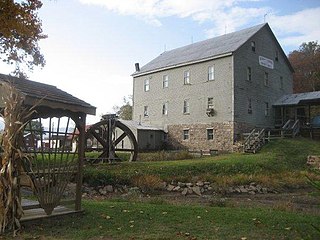
Chambersburg is a borough in and the county seat of Franklin County, in the South Central region of Pennsylvania, United States. It is in the Cumberland Valley, which is part of the Great Appalachian Valley, and 13 miles (21 km) north of Maryland and the Mason-Dixon line and 52 miles (84 km) southwest of Harrisburg, the state capital. According to the United States Census Bureau, Chambersburg's 2020 population was 21,903. When combined with the surrounding Greene, Hamilton, and Guilford Townships, the population of Greater Chambersburg is 52,273 people. The Chambersburg, PA Metropolitan Statistical Area includes surrounding Franklin County, and in 2010 included 149,618 people.

The David Bradford House is a historic house museum at 175 South Main Street in Washington, Pennsylvania. Completed in 1788, it was the home of David Bradford, a leader of the Whiskey Rebellion. It has both architectural and historic importance, and was designated a National Historic Landmark in 1983. It is open weekly between April and November, or by appointment.

The Cumberland Valley Railroad was an early railroad in Pennsylvania, United States, originally chartered in 1831 to connect with Pennsylvania's Main Line of Public Works. Freight and passenger service in the Cumberland Valley in south central Pennsylvania from near Harrisburg to Chambersburg began in 1837, with service later extended to Hagerstown, Maryland, and then extending into the Shenandoah Valley to Winchester, Virginia. It employed up to 1,800 workers.

Burnt Cabins is a historic unincorporated community in Dublin Township, Fulton County, Pennsylvania, United States, at the foot of Tuscarora Mountain. It is approximately three miles west of the Tuscarora Mountain Tunnel on I-76 and the turnpike runs within 100 yards of the village. U.S. Route 522 also runs through the village.

The current Franklin County Courthouse in Chambersburg, Pennsylvania, built in 1865, is the third courthouse building on the site. The site was originally purchased from Colonel Benjamin Chambers in 1785.

Fort Gaddis is the oldest known building in Fayette County, Pennsylvania and the second oldest log cabin in Western Pennsylvania. It is located 300 yards (270 m) east of old U.S. Route 119, near the Route 857 intersection in South Union Township, Pennsylvania. Fort Gaddis was built about 1769-74 by Colonel Thomas Gaddis who was in charge of the defense of the region, and his home was probably designated as a site for community meetings and shelter in times of emergency, hence the term "Fort Gaddis," probably a 19th-century appellation. It is a 1 1/2-story, 1-room log structure measuring 26 feet long and 20 feet wide.

Birmingham Friends Meetinghouse is a historic Quaker meeting house at 1245 Birmingham Road in Birmingham Township, Chester County, Pennsylvania. The current meetinghouse was built in 1763. The building and the adjacent cemetery were near the center of fighting on the afternoon of September 11, 1777 at the Battle of Brandywine. Worship services are held weekly at 10am. The meetinghouse and adjacent octagonal schoolhouse were listed on the National Register of Historic Places as Birmingham Friends Meetinghouse and School on July 27, 1971.

Catawissa Friends Meetinghouse is a historic Quaker meetinghouse at South and 3rd Streets in Catawissa, Columbia County, Pennsylvania. It was built about 1789, and is a one-story log building on a stone foundation. It measures 30 feet (9.1 m) by 27 feet 6 inches (8.38 m).

The Rocky Spring Presbyterian Church is an historic, American Presbyterian church that is located in Letterkenny Township, Franklin County, Pennsylvania, United States.

Mingo Creek Presbyterian Church and Churchyard is a church and historic location in Washington County, Pennsylvania. It is located at the junction of Pennsylvania Route 88 and Mingo Church Road in Union Township, Washington County, Pennsylvania, near Courtney, Pennsylvania. It is a member of the Washington Presbytery.

The LeMoyne Crematory was the first crematory in the United States. Francis Julius LeMoyne had it built in 1876 on his own land, perched atop a location known locally as Gallow's Hill in North Franklin Township near Washington, Pennsylvania. The first cremation took place on December 6, 1876. LeMoyne believed that cremation was a more sanitary way to dispose of bodies, preventing the contamination of drinking water. After 41 more cremations there, the crematory was closed in 1901. LeMoyne's remains are buried there.

The Chads House, which was built by John Wyeth Jr. for John Chads, is located in Chadds Ford, Delaware County, Pennsylvania. The house was built after 1712 and was added to the National Register of Historic Places on March 11, 1971. John Chad's widow, Elizabeth, stayed in the house while it was in the line of fire during the Battle of Brandywine. The city of Chadds Ford relied on the spring ford on the property, and thus the city was named after John Chads.

The Susquehanna County Courthouse Complex, also known as the Susquehanna County Courthouse & Jail, is an historic, American courthouse complex that is located in Montrose, Susquehanna County, Pennsylvania. The complex consists of four contributing buildings, one contributing site, and four contributing objects.

Schmucker Hall is an American Civil War site listed on the National Register of Historic Places in Adams County, Pennsylvania, that was constructed as the original Gettysburg Theological Seminary building. Used as both a Union and Confederate hospital during the 1863 Battle of Gettysburg, the facility served as the seminary's main building from 1832 to 1895, then as a dedicated dormitory for students until 1951. In 1960, it was leased by the Adams County Historical Society. Beginning in 2006, the Historical Society, along with the Seminary Seminary Ridge Historic Preservation Foundation, rehabilitated the building for adaptive reuse as the Seminary Ridge Museum. The Adams County Historical Society moved into the nearby Wolf House on the seminary campus preceding the renovation. In 2013, on the 150th anniversary of the battle, the Seminary, the Adams County Historical Society and the Seminary Ridge Historic Preservation Foundation opened the building as the Seminary Ridge Museum. The Museum houses displays about many different aspects of the battle, the seminary, the town, and the civil war, and the struggle among faith groups over slavery, as well as offering tours of the cupola. The exhibit and museum have earned international, national and regional awards and the rehabilitation achieved LEED Certification in 2013.

The John Brown House, also known as the Ritner Boarding House, is an historic American home that is located in Chambersburg in Franklin County, Pennsylvania.

Chambersburg Historic District is a national historic district centered on the Memorial Fountain and Square of Chambersburg in Franklin County, Pennsylvania. The district includes 159 contributing buildings in the central business district and immediately surrounding residential area of Chambersburg. The district has a number of notable examples of Georgian and Italianate style architecture. Notable buildings include the St. Paul United Methodist Church (1896), Professional Arts Building, Cumberland Valley National Bank, Cumberland Valley Railroad Station, First United Brethren Church (1899), firehouse, Presbyterian Church of the Falling Spring (1803), and the Suesserott House. Located in the district and separately listed are the Franklin County Jail, Franklin County Courthouse, John Brown House, Masonic Temple, Townhouse Row, and the Zion Reformed Church.

Witmer's Tavern, is an historic structure that is located in East Lampeter Township, Lancaster County, Pennsylvania, just east of U.S. 30 on Old Philadelphia Pike. This building known as Witmer's Tavern should not be confused with the other Witmer's Tavern more commonly known as the Conestoga Restaurant or Conestoga Inn that is located on Route 462 at Bridgeport just east of Lancaster City.

The Old Customshouse is an historic, American custom house building that is located in Erie, Erie County, Pennsylvania.

The Great Valley Mill, also known as the Old Grist Mill in the Great Valley, is an historic grist mill which is located in Tredyffrin Township, Chester County, Pennsylvania.

The Reading Furnace Historic District is a national historic district that is located in Warwick Township and East Nantmeal Township, Chester County, Pennsylvania.























